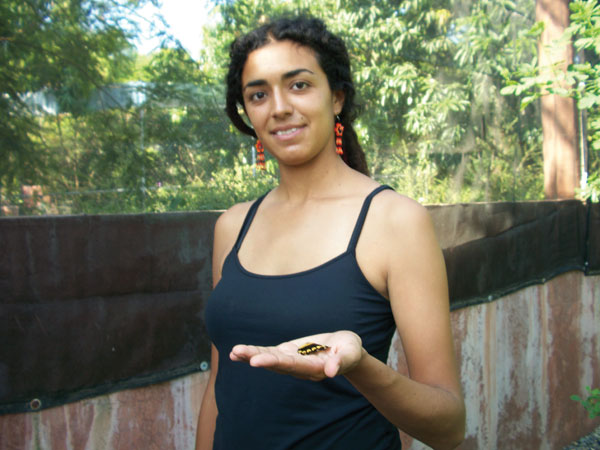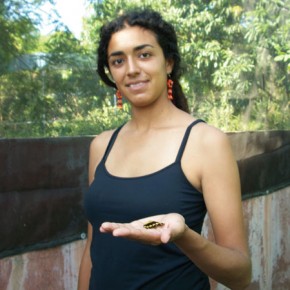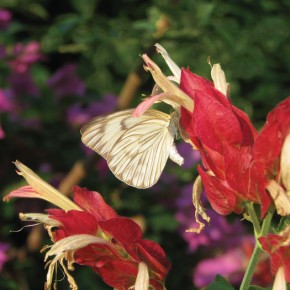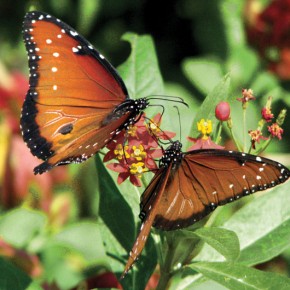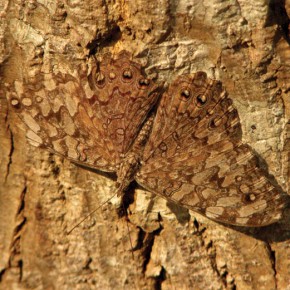Until recently, only fifty-nine species of butterflies had been formally cataloged by naturalists working in the Zihuatanejo area early in the twentieth century, but thanks to an ambitious college thesis project by Mexico City biology major Ana Luisa Figueroa, that number is up to 155 and still climbing.
Figueroa began her work at El Refugio de Potosi in November, 2009, thinking to complete it in half a year, but the unexpected wealth of mariposas (butterflies) persuaded her to extend the study until April, 2011, much to the delight of El Refugio’s director, Laurel Patrick, who informed me butterflies and hummingbirds are “indicator species” that clue us in to the environment’s general health.
“Ana’s work is proving how rich this area’s biodiversity is so we can create a desire to protect it,” Patrick said. “It gives us a baseline for what we have here now so we can compare against it in the future.”
Figueroa’s enthusiasm for her study is contagious. I wish I could have seen her decked out in head-to-toe protective gear to take scientific measurements in one of the six butterfly habitats she’s defined. During one particularly memorable prior outing early in the project, Figueroa was attacked by bees after blazing a trail up a hill across from the Barra de Potosi lagoon and “walking the grid” to count specimens and chart distribution patterns. Despite using a butterfly net to cover her head, Ana nevertheless suffered more than 100 stings and was rushed to a clinic by a distraught Patrick. (She’s fine now.)
The six habitats Figueroa monitors range from the acacia forest at El Refugio and a nearby palm plantation to the mangroves near Barra de Potosi’s lagoon (reached by kayak) and “the Dunes,” a hidden beach not far away which ranks as Ana’s personal favorite. Different vegetation attracts different types of butterflies, so the population varies significantly from one location to another.
Worldwide, there are about 150,000 species of insects with articulated legs – called arthropods – within many families belonging to the Lepidoptera order, which includes both butterflies and the much more prevalent moths, roughly 13%, about 19,500 are butterflies. Figueroa estimates she might find another twenty-five mariposa species here before she’s done, upping the Zihuatanejo tally to 180. Early in her study, she identified forty in one day, but now it’s much harder to spot new varieties.
There are but six families in Mexico’s butterfly world, Ana told me, and the most diverse are the brushfoots, one species being the popular Monarch. Do we have any of them here? I wondered. Ana’s seen but one lone Monarch in almost a year, though our neighboring state of Michoacán boasts millions.
Zihuatanejo has about fifty kinds of brushfoots. The most entertaining variety I saw were the Gray Crackers, who make a crackling noise when they play with each other in the air. The various types of Crackers are the only noisy butterflies, Ana told me. By far the most prevalent local species is the Great Southern White, belonging to the whites and yellows family. The tips of its antennae, called clubs, are turquoise. I saw them and many others recently at El Refugio de Potosi’s temporary butterfly house. Plans to build a more permanent structure are in the works, but progress will depend on rustling up funds for the project.
Patrick said the green and black Malachite, another brushfoot, is one of her favorites, adding that butterfly enthusiasts travel long distances to see them in person, given they only live in the tropics. Unlike many species which pretty much stay in one place, Mexico’s Malachites migrate to different places within the country, though their voyages are short compared to the international route flown by Michoacán Monarchs.
The Yellow Sulphur butterflies (another white and yellow), the lovely brown and red Postman and the Zebra (both brushfoot) species are prolific in our area, especially during the rainy season, when the population grows like crazy. The other four families are the swallowtails, the metal marks, the hair streaks, and the skippers.
Though you might not think it, butterflies – like people – have different personalities. Some fly high, and some fly low. Some are very sensitive, and some are much smarter than others, Figueroa said. Some can adapt for many conditions while others have to stay put or die. Butterflies start out as eggs lain on a host plant, progress to caterpillars, and morph into a chrysalis where the adult matures, and emerge as mature butterflies. Life spans for the full cycle range from about one to eight months, with the Malachites spending a lengthy four months fluttering about as adults. Butterflies tend to be territorial, Figueroa said, but more so within their species than between them.
Though most feed on nectar, some species prefer fermented fruit, Ana told me. Some of their archenemies include spiders, scorpions, lizards and birds. Basically, they’re at the very bottom of the food chain. Though they may look like they have not a care in the world as they float on by, life is not easy when you’re a butterfly. Coloration sometimes differentiates the males from the females, but body shape is a bigger clue.
Figueroa’s finished thesis titled: Diagnostics of the Butterfly Fauna of Playa Blanca and Laguna de Potosi, will be the culmination of her efforts to earn a B.A. degree in biology from Universidad Autonoma Metropolitana (UAM) in Xochimilco near Mexico City. She’s also creating a folding pocket field guide, complete with photos, of the fifty most common butterfly species in this area. It will be available at El Refugio de Potosi when completed. You can find out more about El Refugio de Potosi at www.elrefugiodepotosi.org.
- Ana Luisa Figueroa cradling the wing of a giant swallowtail butterfly from the “swallowtail” family. Photo by Nancy Seeley
- Ascia Monuste. Photo by Ana Luisa Figueroa.
- Danaus Gilippus. Photo by Ana Luisa Figueroa.
- Euptieta Hegesia. Photo by Ana Luisa Figueroa.
- Hamadryas Februa. Photo by Ana Luisa Figueroa.
- Heliconius Charithonia. Photo by Ana Luisa Figueroa.
- Heraclides Cresphontes. Photo by Ana Luisa Figueroa.

